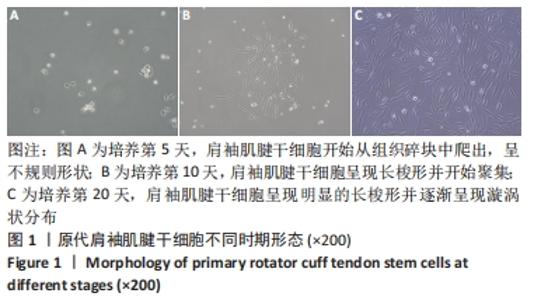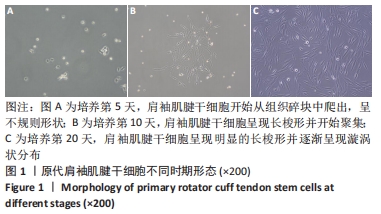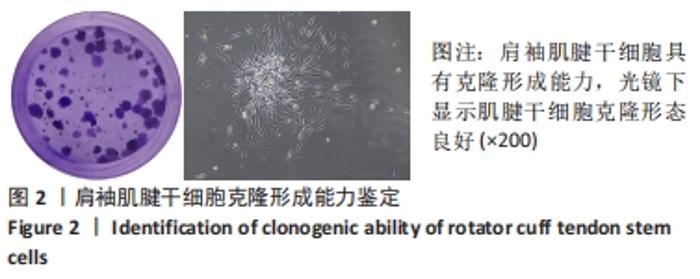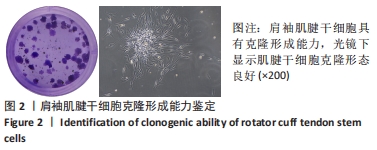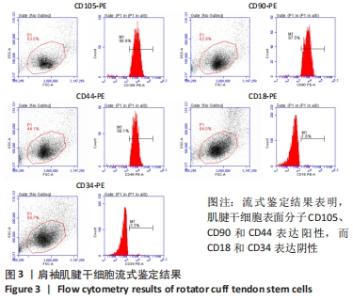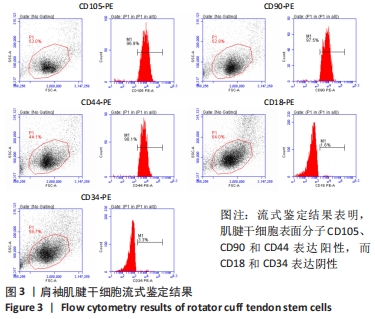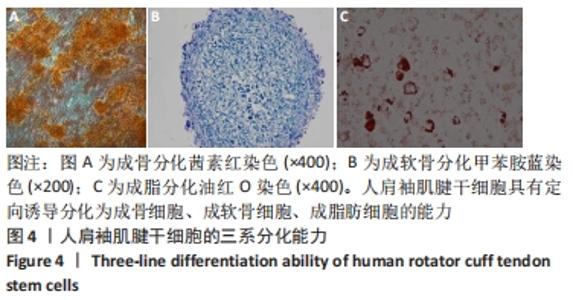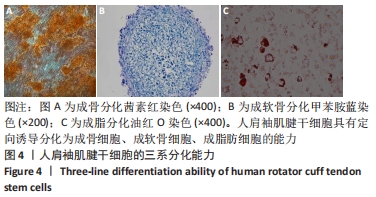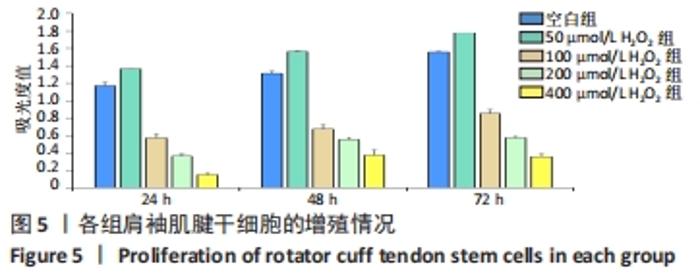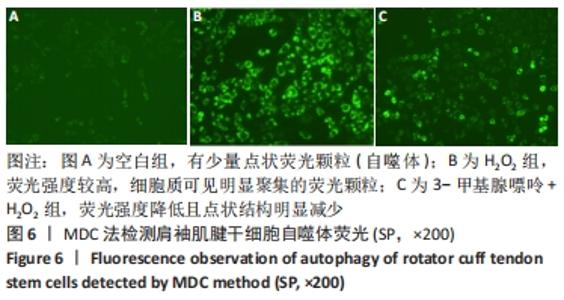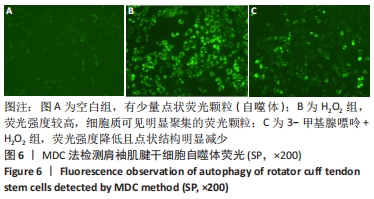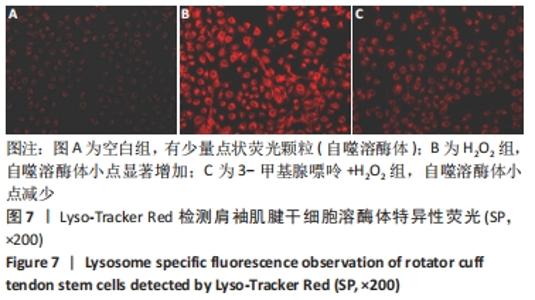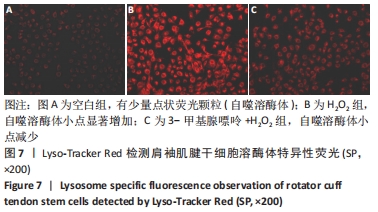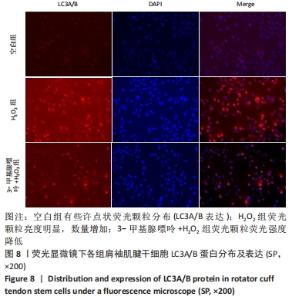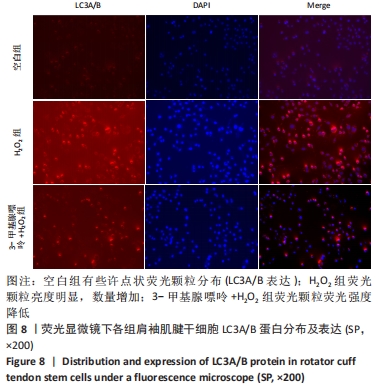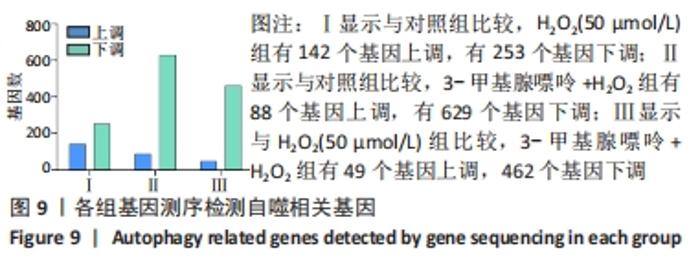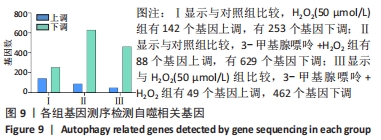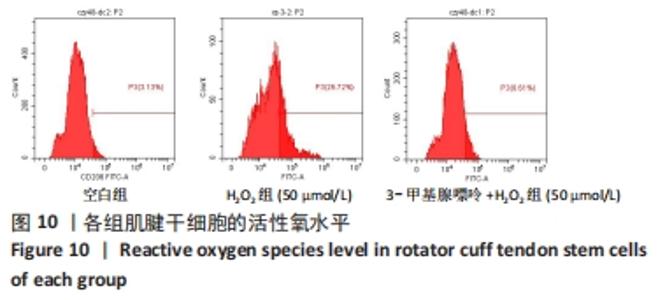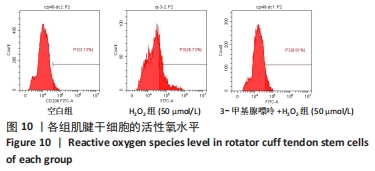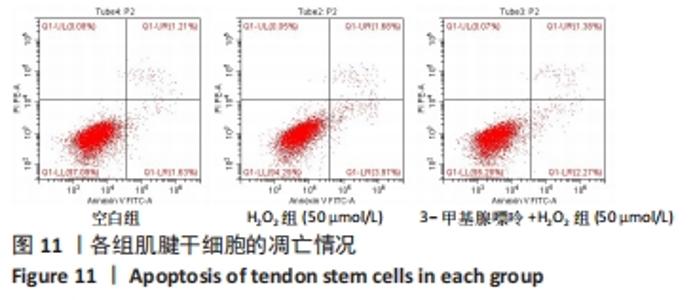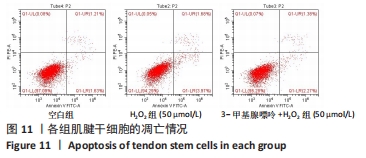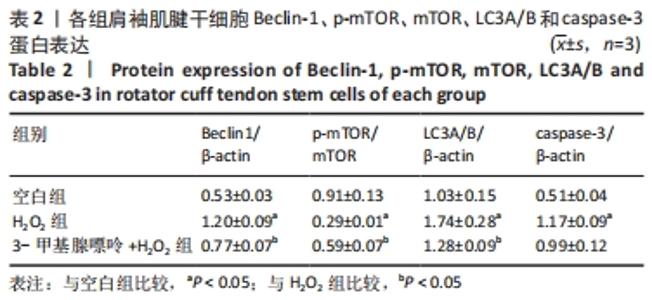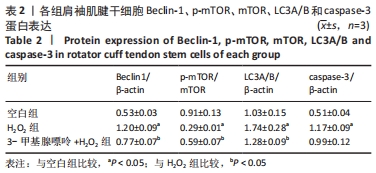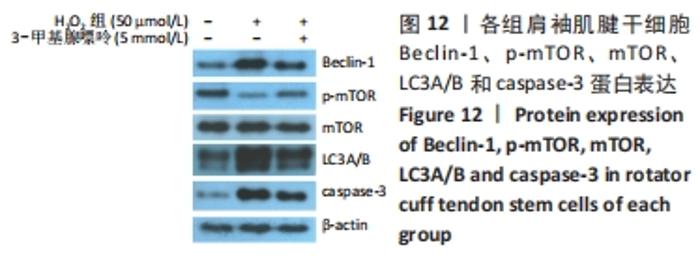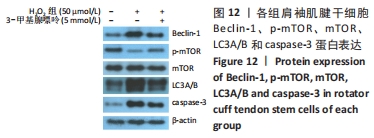Chinese Journal of Tissue Engineering Research ›› 2022, Vol. 26 ›› Issue (31): 4954-4961.doi: 10.12307/2022.954
Previous Articles Next Articles
Expression of autophagy in rotator cuff tendon stem cells induced by oxidative stress
Wei Hewei1, Zheng Weipeng1, Liu Zhijun1, Zhao Guoyuan2, Fang Weihua2, Chen Sheng1, Liao Zhihao1, Wan Lei1
- 1The Third Affiliated Hospital of Guangzhou University of Chinese Medicine, Guangzhou 510375, Guangdong Province, China; 2Guangzhou University of Chinese Medicine, Guangzhou 510006, Guangdong Province, China
-
Received:2021-07-17Accepted:2021-12-22Online:2022-11-08Published:2022-04-24 -
Contact:Liu Zhijun, Master, Attending physician, The Third Affiliated Hospital of Guangzhou University of Chinese Medicine, Guangzhou 510375, Guangdong Province, China -
About author:Wei Hewei, MD, Chief physician, The Third Affiliated Hospital of Guangzhou University of Chinese Medicine, Guangzhou 510375, Guangdong Province, China Zheng Weipeng, Master, Attending physician, The Third Affiliated Hospital of Guangzhou University of Chinese Medicine, Guangzhou 510375, Guangdong Province, China Wei Hewei and Zheng Weipeng contributed equally to this article. -
Supported by:Guangdong Provincial Bureau of Traditional Chinese Medicine Research Project, No. 20203011 (to WHW); the Guangdong Provincial Traditional Chinese Medicine Research Project, No. 20191178 (to ZWP); the Guangdong Provincial Medical Science and Technology Research Fund Project, No. B2020030 (to LZJ)
CLC Number:
Cite this article
Wei Hewei, Zheng Weipeng, Liu Zhijun, Zhao Guoyuan, Fang Weihua, Chen Sheng, Liao Zhihao, Wan Lei. Expression of autophagy in rotator cuff tendon stem cells induced by oxidative stress[J]. Chinese Journal of Tissue Engineering Research, 2022, 26(31): 4954-4961.
share this article
Add to citation manager EndNote|Reference Manager|ProCite|BibTeX|RefWorks
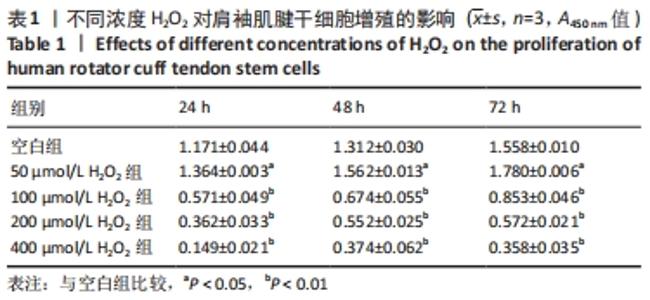
2.2 不同浓度H2O2模拟氧化应激状态对肩袖肌腱干细胞增殖能力的影响 使用0,50,100,200,400 μmol/L H2O2干预肩袖肌腱干细胞24,48,72 h,与空白组对比,50 μmol/L H2O2组细胞吸光度值显著升高(P < 0.05),而100,200,400 μmol/L H2O2组细胞吸光度值显著降低(P < 0.05),结果显示,随着H2O2浓度的增加,肩袖肌腱干细胞增殖活性下降,差异有显著性意义(P < 0. 05)。当H2O2浓度为50 μmol/L 时,肩袖肌腱干细胞增殖活性最强,因此采用50 μmol/L H2O2模拟肩袖肌腱干细胞氧化应激状态,见表1和图5。"
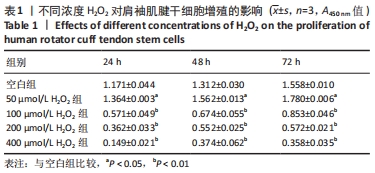
| [1] 骆勇刚,陈俊,庄万强,等.肩关节镜下不同缝合固定修复技术治疗肩袖损伤的临床疗效[J].局解手术学杂志,2021,30(6):535-540. [2] 段宝霖,鲍文强,黄佑庆,等.肩关节疼痛神经阻滞疗法中国专家共识(2020版)(第一部分)[J].中华疼痛学杂志,2020,16(5):349-360. [3] 张阳洋,杨星光,赵金忠.伴有骨质疏松的肩袖损伤治疗进展[J].国际骨科学杂志,2016,37(4):214-218. [4] 敖英芳.关节镜外科学[M].北京:北京大学医学出版社,2012. [5] CHUNG SW, OH JH, GONG HS, et al. Factors affecting rotator cuff healing after arthroscopic repair: osteoporosis as one of the independent risk factors. Am J Sports Med. 2011;39(10):2099-2107. [6] RUDZKI JR, ADLER RS, WARREN RF, et al. Contrast-enhanced ultrasound characterization of the vascularity of the rotator cuff tendon: age- and activity-related changes in the intact asymptomatic rotator cuff. J Shoulder Elbow Surg. 2008;17(1 Suppl):96S-100S. [7] SUGAYA H, MAEDA K, MATSUKI K, et al. Repair integrity and functional outcome after arthroscopic double-row rotator cuff repair. A prospective outcome study. J Bone Joint Surg Am. 2007;89(5):953-960. [8] WLASCHEK M, SCHARFFETTER-KOCHANEK K. Oxidative stress in chronic venous leg ulcers. Wound Repair Regen. 2005;13(5):452-461. [9] 尚小可,郑君,余子杨,等.肩袖损伤的处理临床实践指南(2019年)解读[J].中华肩肘外科电子杂志,2021,9(2):103-111. [10] LEE S, HWANG JT, LEE SS, et al. Greater Tuberosity Bone Mineral Density and Rotator Cuff Tear Size Are Independent Factors Associated With Cutting-Through in Arthroscopic Suture-Bridge Rotator Cuff Repair. Arthroscopy. 2021;37(7):2077-2086. [11] YAMAGUCHI K, DITSIOS K, MIDDLETON WD, et al. The demographic and morphological features of rotator cuff disease. A comparison of asymptomatic and symptomatic shoulders. J Bone Joint Surg Am. 2006; 88(8):1699-1704. [12] 邓炜聪,曾勤,洪钟源,等.富血小板血浆治疗肩袖损伤术后的疗效:随机对照试验Meta分析[J].创伤外科杂志,2021,23(4):276-284. [13] 韦继南,李永刚,耿锐,等.LafosseⅠ型肩胛下肌损伤修复与否对前上方肩袖损伤修复疗效的影响[J].中华骨科杂志,2020,40(23): 1612-1622. [14] SCHÄFER M, WERNER S. Oxidative stress in normal and impaired wound repair. Pharmacol Res. 2008;58(2):165-171. [15] 冯加劲,向明,赵磊.全层肩袖损伤的分类、损伤机制及修复方法的研究进展[J].世界最新医学信息文摘,2019,19(20):132-133. [16] 陈亚敏,文政芳,王国霞.褪黑素对缺氧缺血性脑损伤新生大鼠皮层氧化应激的影响[J].神经解剖学杂志,2021,37(3):305-309. [17] 赵智龙,丁国萍,胡媛,等.银质针对大鼠肩袖冈上肌骨-肌腱结合部位损伤的修复作用[J].宁夏医学杂志,2021,43(6):535-538. [18] 余静雅,戴燕,石玉兰.慢性伤口细菌生物膜的研究进展[J].华西医学,2021,36(5):686-690. [19] 李凯群.高胆固酵通过激活ROS介导的NF-кB通路抑制肌腱干细胞的腱系分化[D].广州:南方医科大学,2019. [20] 谭济阳. 肩关节镜下治疗合并骨质疏松的肩袖损伤的疗效分析[D].扬州:扬州大学,2019. [21] LANG JY, MA K, GUO JX, et al. Oxidative stress induces B lymphocyte DNA damage and apoptosis by upregulating p66shc. Eur Rev Med Pharmacol Sci. 2018;22(4):1051-1060. [22] TANG C, LIANG J, QIAN J, et al. Opposing role of JNK-p38 kinase and ERK1/2 in hydrogen peroxide-induced oxidative damage of human trophoblast-like JEG-3 cells. Int J Clin Exp Pathol. 2014;7(3):959-968. [23] 宋慧芳,谈佳音,康毅,等.低氧预处理增强老年人骨髓间充质干细胞条件培养基对H9C2细胞氧化应激损伤的保护作用[J].中国组织工程研究,2022,26(1):1-6. [24] 付国建,尹峰.干细胞治疗慢性巨大肩袖损伤的研究进展[J].同济大学学报(医学版),2019,40(6):877-883. [25] 廖昊燃,余伟林,胡庆翔,等.生物学方法促进肩袖腱骨愈合研究进展[J].中华肩肘外科电子杂志,2021,9(2):183-186. [26] 刘嘉鑫,安丽萍,张广瑞,等.促进肩袖止点腱骨愈合的研究进展[J].中国骨伤,2020,33(7):684-688. [27] BI Y, EHIRCHIOU D, KILTS TM, et al. Identification of tendon stem/progenitor cells and the role of the extracellular matrix in their niche. Nat Med. 2007;13(10):1219-1227. [28] LIANG C. Negative regulation of autophagy. Cell Death Differ. 2010; 17(12):1807-1815. [29] XIE M, MORALES CR, LAVANDERO S, et al. Tuning flux: autophagy as a target of heart disease therapy. Curr Opin Cardiol. 2011;26(3):216-222. [30] CHERRA SJ 3RD, KULICH SM, UECHI G, et al. Regulation of the autophagy protein LC3 by phosphorylation. J Cell Biol. 2010;190(4): 533-539. [31] DJAVAHERI-MERGNY M, MAIURI MC, KROEMER G. Cross talk between apoptosis and autophagy by caspase-mediated cleavage of Beclin 1. Oncogene. 2010;29(12):1717-1719. [32] 梁桂洪,黄和涛,潘建科,等.龙鳖胶囊含药血清对YAP抑制剂诱导人软骨细胞凋亡的保护作用及机制研究[J].中国药房,2021, 32(12):1442-1448. [33] KANG R, ZEH HJ, LOTZE MT, et al. The Beclin 1 network regulates autophagy and apoptosis. Cell Death Differ. 2011;18(4):571-580. [34] 杜洪,夏万松,韦四喜,等.长基因间非编码RNA963不同可变剪接体在胃癌细胞系中的表达和作用[J].贵州医科大学学报,2021, 46(7):759-765. [35] LEVINE B, MIZUSHIMA N, VIRGIN HW. Autophagy in immunity and inflammation. Nature. 2011;469(7330):323-335. [36] YOSHIMORI T. Autophagy: a regulated bulk degradation process inside cells. Biochem Biophys Res Commun. 2004;313(2):453-458. [37] 于海,刘清华,肖培伦,等.Beclin-1,LC3A/B和mTOR在肝癌中的表达及临床意义[J].安徽医药,2018,22(2):246-249. [38] PARGANLIJA D, KLINKENBERG M, DOMÍNGUEZ-BAUTISTA J, et al. Loss of PINK1 impairs stress-induced autophagy and cell survival. PLoS One. 2014;9(4):e95288. [39] KAMINSKYY VO, ZHIVOTOVSKY B. Free radicals in cross talk between autophagy and apoptosis. Antioxid Redox Signal. 2014;21(1):86-102. [40] YAN X, WANG L, YANG X, et al. Fluoride induces apoptosis in H9c2 cardiomyocytes via the mitochondrial pathway. Chemosphere. 2017; 182:159-165. |
| [1] | Cui Wei, Cui Di, Ouyang Ting, Li Xiang, Wei Huiting, Xue Weiyue, Zhou Gang, Qiu Ye. Inhibiting NOX alleviates alcoholic liver damage and lipid metabolism disorder [J]. Chinese Journal of Tissue Engineering Research, 2022, 26(在线): 1-8. |
| [2] | LIU Danni, SUN Guanghua, ZHOU Guijuan, LIU Hongya, ZHOU Jun, TAN Jinqu, HUANG Xiarong, PENG Ting, FENG Wei-bin, LUO Fu. Effect of electroacupuncture on apoptosis of neurons in cerebral cortex of rats with cerebral ischemia-reperfusion injury at "Shuigou" and "Baihui" points [J]. Chinese Journal of Tissue Engineering Research, 2022, 26(在线): 1-6. |
| [3] | Wen Dandan, Li Qiang, Shen Caiqi, Ji Zhe, Jin Peisheng. Nocardia rubra cell wall skeleton for extemal use improves the viability of adipogenic mesenchymal stem cells and promotes diabetes wound repair [J]. Chinese Journal of Tissue Engineering Research, 2022, 26(7): 1038-1044. |
| [4] | Cui Xing, Sun Xiaoqi, Zheng Wei, Ma Dexin. Huangqin Decoction regulates autophagy to intervene with intestinal acute graft-versus-host disease in mice [J]. Chinese Journal of Tissue Engineering Research, 2022, 26(7): 1057-1062. |
| [5] | Zhang Yujie, Yang Jiandong, Cai Jun, Zhu Shoulei, Tian Yuan. Mechanism by which allicin inhibits proliferation and promotes apoptosis of rat vascular endothelial cells [J]. Chinese Journal of Tissue Engineering Research, 2022, 26(7): 1080-1084. |
| [6] | Deng Shuang, Pu Rui, Chen Ziyang, Zhang Jianchao, Yuan Lingyan . Effects of exercise preconditioning on myocardial protection and apoptosis in a mouse model of myocardial remodeling due to early stress overload [J]. Chinese Journal of Tissue Engineering Research, 2022, 26(5): 717-723. |
| [7] | Gao Cangjian, Yang Zhen, Liu Shuyun, Li Hao, Fu Liwei, Zhao Tianyuan, Chen Wei, Liao Zhiyao, Li Pinxue, Sui Xiang, Guo Quanyi. Electrospinning for rotator cuff repair [J]. Chinese Journal of Tissue Engineering Research, 2022, 26(4): 637-642. |
| [8] | Gu Chao, Chen Weikai, Liu Tao, Yang Huilin, He Fan. Mitochondrial dysfunction affects osteogenic differentiation potential of bone marrow mesenchymal stem cells [J]. Chinese Journal of Tissue Engineering Research, 2022, 26(31): 4921-4927. |
| [9] | Zhang Lili, Ou Ya, Yuan Xiaodong, Zhang Pingshu. Bax/Bcl-2 protein and apoptosis during adipose-derived stromal cell differentiation into astrocytes [J]. Chinese Journal of Tissue Engineering Research, 2022, 26(31): 4982-4987. |
| [10] | Li Zulong, Rong Zhen, Sun Hua, Jiang Ruiyuan, Zhong Xiaoting, Mo Chunmei. Mechanism underlying the effect of Fuhebeihua Recipe on the proliferation of CD133+HepG2 hepatoma stem cells and related autophagy proteins [J]. Chinese Journal of Tissue Engineering Research, 2022, 26(31): 4988-4995. |
| [11] | Wang Kang, Zhi Xiaodong, Zhang Yuqiang, Gong Chao, Wang Chenliang, Wang Wei. Human amniotic epithelial cells regulate the proliferation, apoptosis and extracellular matrix synthesis of articular chondrocytes by activating the EGFR/ERK1 signaling axis [J]. Chinese Journal of Tissue Engineering Research, 2022, 26(31): 4967-4974. |
| [12] | Zheng Meijie, Yang Weizhe, Liu Jialin, Han Xiangzhen, Zhou Qiqi, He Huiyu. Apoptosis of mouse bone marrow-derived macrophages induced by lipopolysaccharide [J]. Chinese Journal of Tissue Engineering Research, 2022, 26(31): 4962-4966. |
| [13] | Li Suyao, Guo Minfang, Yu Jingwen, Meng Tao, Mu Bingtao, Li Mengdi, Li Na, Song Lijuan, Ma Cungen, Yu Jiezhong. Effect of eriodictyol on the imbalance of mitochondrial dynamics and apoptosis in SH-SY5Y cells induced by hydrogen peroxide [J]. Chinese Journal of Tissue Engineering Research, 2022, 26(31): 4975-4981. |
| [14] | Wu Huiting, Zhu Dacheng, Xu Xiaoming, Chang Na. Ethanol extract of toosendan induces apoptosis of leukemia CEM cells through mitochondrial pathway [J]. Chinese Journal of Tissue Engineering Research, 2022, 26(30): 4873-4878. |
| [15] | Wu Yafei, Zhu Liang, Ren Qiujian, Li Daen, Li Dadi, Gao Xuren, Guo Kaijin. Relationship between glenoid version angle and degenerative rotator cuff full-thickness tear: matched case control trial [J]. Chinese Journal of Tissue Engineering Research, 2022, 26(3): 435-439. |
| Viewed | ||||||
|
Full text |
|
|||||
|
Abstract |
|
|||||
